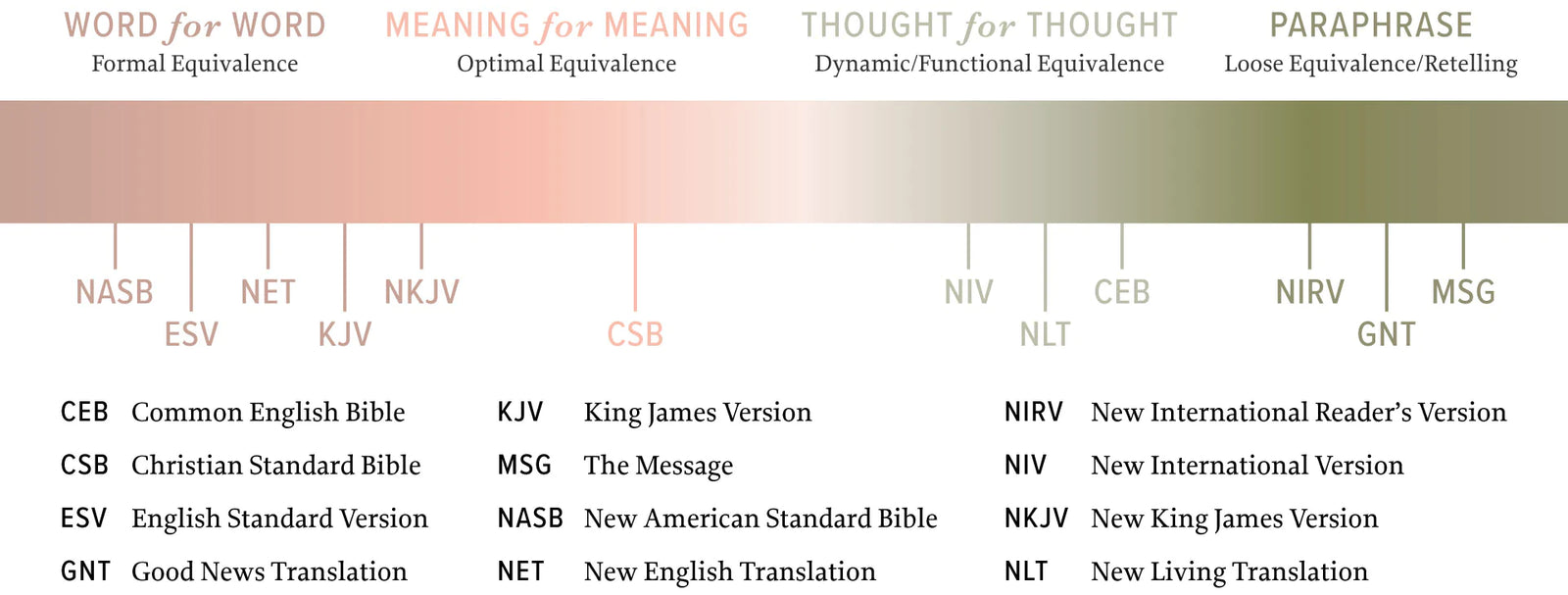Translations
Hosanna Revival Bibles are available in four translations: English Standard Version (ESV), New Living Translation (NLT), Christian Standard Bible (CSB), and the King James Version (KJV). The KJV is a literal translation of the Bible commissioned in 1604 by King James I of England and printed in 1611 and built upon the earliest English translations of the Bible, namely the Bishop’s Bible, Tyndale’s Bible, Coverdale’s, Matthew’s, and the Geneva Bible. The ESV is an “essentially literal” translation (sometimes called “functional equivalence” or “word-for-word”), which attempts to retain as much of the original sentence structure and idioms as possible. The NLT is a “meaning-based” translation (sometimes called “dynamic equivalence” or “thought-for-thought”), a which attempts to render the original meaning of the text in clear, modern English. The CSB attempts to find a balance between functional and dynamic equivalence, balancing the readability of the text with the original meaning.
The ESV Translation
The English Standard Version (ESV) is an “essentially literal” translation of the Bible in contemporary English. Created by a team of more than 100 leading evangelical scholars and pastors, the ESV Bible emphasizes “word-for-word” accuracy, literary excellence, and depth of meaning. Since its publication in 2001, the ESV Bible has gained wide acceptance and is used by church leaders, numerous denominations and organizations, and millions of individuals around the world.
The ESV is equally suited for public reading and preaching, for private reading and reflection, for both academic and devotional study, and for Scripture memorization.
The KJV Translation
The King James Version is a translation named after King James I of England who commissioned the new English Bible translation in 1604 A.D. King James authorized the new translation to be read in churches in England and beyond after it was first published in 1611 A.D. Later known as the “Authorized Version” in 1814, the King James Version became a standard among English-speaking Christians. The translation is most noted for its poetic prose that seems to flow with a certain rhythmic quality.

The CSB Translation
The Christian Standard Bible was translated using optimal equivalence, focused on being faithful to the original languages without sacrificing readability. The CSB text has been proven to optimize both readability and clarity, while maintaining linguistic precision, making it an excellent translation for reading, study, and preaching.
The goal of the translation committee of the Christian Standard Bible was for the modern reader to hear the Word of God in their “mother tongue,” just as the original audience would have. Rather than taking each word and finding the most accurate English equivalent, they attempted to translate the Bible on a ‘meaning-for-meaning” basis. The result is a Bible translation with excellent readability that remains faithful to the text of Scripture.
The NLT Translation
The New Living Translation combines the latest biblical scholarship with a clear, dynamic writing style that communicates God’s Word powerfully to all who hear and read it. It renders the message of the original texts of Scripture into clear, contemporary English that was written to be read aloud. With a focus on clarity, The New Living Translation invites readers to go deeper into the biblical text to discover God’s story for their lives and the world.
The New Living Translation uses the meaning-based translation model. In meaning-based translations, the translators start with a source-language text and dig beneath the surface to discover its meaning. The translators then search for the best ways to re-express that meaning using words and phrases from the language into which the text is being translated.

Choosing a Translation
One of the questions we often receive here at Hosanna Revival is, “What are the differences between the Bible translations you offer?” Sometimes, what people really want to know is, “Which Bible translation is best?” The truth is, there’s no one right answer to that question. In fact, we think a better question is, “Which Bible translation is best for me?” Before we can answer that question, we need to understand a little bit more about how the Bible is translated. There are two main translation philosophies when it comes to translating the Bible:
1. Word-for-Word translation (also known as “essentially literal” or “formal equivalence”)
2. Thought-for-Thought translation (also known as “functional equivalence,” or “dynamic equivalence,” or “meaning-based”)
In recent years, some Bible translations have attempted to fall somewhere between these two philosophies, forming a “natural equivalence” or “optimal equivalence” translation philosophy. In addition to these three translation philosophies, some have chosen a different method altogether, resulting in a paraphrased retelling of Scripture.

Our Translations
Hosanna Revival Bibles are available in four translations: English Standard Version (ESV), King James Version (KJV) New Living Translation (NLT), and Christian Standard Bible (CSB). The KJV is a literal translation, and the ESV is an “essentially literal” translation (sometimes called “functional equivalence” or “word-for-word”), which attempt to retain as much of the original sentence structure and idioms as possible. The NLT is a “meaning-based” translation (sometimes called “dynamic equivalence” or “thought-for-thought”), a which attempts to render the original meaning of the text in clear, modern English. The CSB attempts to find a balance between functional and dynamic equivalence, balancing the readability of the text with the original meaning.
Other Translations
If you’re looking for a Catholic Bible (particularly a Catholic journaling Bible), you might be interested in this one.













